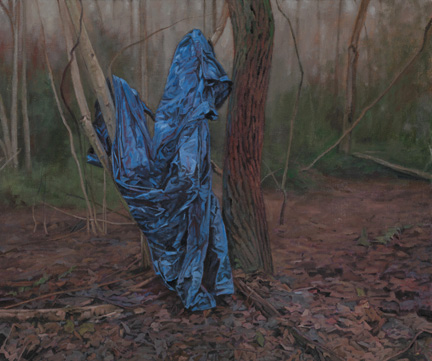The other day I was in the National Gallery (top tip: it's the best place to escape the London heat - perfect temperature control and great art wherever you look) and went to have a look at George Shaw's punningly titled new exhibition, My Back to Nature. I've liked Shaw ever since I first saw his extraordinary paintings of the Coventry housing estate - Tile Hill - where he grew up. He paints not with oils but with Humbrol enamel paint - the stuff we boys used to paint our Airfix kits with - which must present mind-boggling technical challenges; and he's habitually painted on sheets of MDF, but for this exhibition, in deference to his surroundings and his inspirations, he has switched to canvas.
Shaw has been working at the National Gallery as an 'associate artist' for two years, free to roam the galleries at all hours and work in a studio within the building. The pictures in My Back to Nature are painted in response to works on the gallery walls - notably the three great Titian Diana paintings, and works by Poussin, Bellini (The Assassination of St Peter Martyr), Crivelli (The Dead Christ Supported by Two Angels) and Constable (Cenotaph to the Memory of Sir Joshua Reynolds). Shaw's subject matter, however, remains firmly rooted in the urban edgelands that are his spiritual home - in this case, a patch of scruffy urban woodland, strewn with rubbish and strange abandoned objects.
These woodland scenes, meticulously painted, are imbued with mystery, magic and possibility - just as such places are in reality, or seemed to us in our early years, when urban woodland was a private place of secrets, transgressions, initiations. The pictures are all empty of people (with one exception, The Call of Nature, which depicts the artist urinating against a tree - his back to nature indeed) and many have the sense of something interrupted, of people or presences having just left, perhaps lurking somewhere out of sight (most strikingly in The Heart of the Wood, below). They have resonant titles that chime intriguingly with the mundane subject matter: The School of Love (title from Coreggio) is a grubby abandoned mattress, The Old Master depicts a tree with a crude cock-and-balls sprayed on it and The Old Country a tree with a decidedly anatomical cleft, Natural Selection shows pages from porn mags scattered at the foot of a tree (other porn litter is depicted under the titles The Lost and The Tossed - Shaw likes a joke).
All this talk of pornography and litter might suggest that Shaw's paintings are exercises in gritty dirty realism, but they project something much bigger, more ambitious and more potent than that, something that has much to do with the artist's long immersion in the Gallery's collections. Classical myth (especially metamorphoses) and Christian iconography imbue these pictures, setting up powerful resonances - and the extent to which Shaw has immersed himself in Christian imagery is emphasised dramatically in a remarkable series of drawings in which the artist assumed the positions of Christ in the traditional Stations of the Cross. The climax of the exhibition though is a set of three large canvases hung together - The Rude Screen, Möcht’ ich zurücke wieder wanken (a line from the eighth song of Winterreise) and Every Brush Stroke Is Torn from My Body (a quotation from Tony Hancock's The Rebel). It's hard to convey the impact these paintings - and many others in the exhibition - make when you see them on the canvas. I can only suggest that you head for the Sunley Room at the National Gallery and see for yourself. My Back to Nature is on until the end of October.
Monday, 25 July 2016
Subscribe to:
Post Comments (Atom)


Thank you. I read Wademar Januszczak on him a little while back and you've added to my being intrigued. Will seek him out. http://www.thetimes.co.uk/article/waldemar-januszczak-bark-with-bite-k6vtlhr56
ReplyDelete